|
|
 |
|
Calanoida ( Order ) |
|
|
|
Clausocalanoidea ( Superfamily ) |
|
|
|
Aetideidae ( Family ) |
|
|
|
Chiridius ( Genus ) |
|
|
| |
Chiridius polaris Wolfenden, 1911 (F,M) | |
| | | | | | | Syn.: | ? Chiridius gracilis : A. Scott, 1909 (p.42, figs.F); ? Tanaka, 1937 (p.255, figs.F);
? Chiridius obtusifrons : A. Scott, 1909 (p.43, figs.F);
Chiridius subantarcticus Park, 1978 (p.125, figs.F) | | | | Ref.: | | | Wolfenden, 1911 (p.211, Descr.F, figs.F); Farran, 1929 (p.208, 229, Rem.F); Sewell, 1948 (p.574); Brodsky, 1950 (1967) (p.152, figs.F); Vervoort, 1957 (p.6, 53, figs.F, Rem.); Park, 1978 (p.124, Rem.); Gardner & Szabo, 1982 (p.214, figs.F,M); Markhaseva, 1996 (p.119, Descr.M, figs.F,M, Rem.); Bradford-Grieve & al., 1999 (p.879, 920, figs.F,M) | 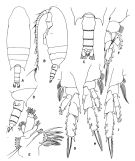 issued from : T. Park in Antarctic Res. Ser. Washington, 1978, 27. [p.126, Fig.14]. As Chiridius subantarcticusFemale: A, habitus (dorsal view); B, idem (left lateral side); C, posterior part of metasome and urosome (dorsal view); D, idem (left lateral side); E, Mx1; F, P1; G, P2; H, P3; I, P4. Legs 1-4: anterior view.
|
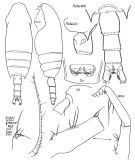 issued from : E.L. Markhaseva in Proc. Zool. Inst. RAN, St. Petersburg, 1996, 268. [p.124, Fig.94]. Female (from different localities). Ce: forehead (lateral); Gngenital field (ventral)..
|
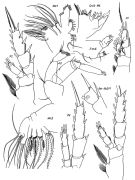 issued from : E.L. Markhaseva in Proc. Zool. Inst. RAN, St. Petersburg, 1996, 268. [p.125, Fig.95]. Female (from different specimens). Re: exopod; P.md: mandibular palpGntbMd: gnathobase of Md (partial).
|
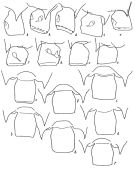 issued from : E.L. Markhaseva in Proc. Zool. Inst. RAN, St. Petersburg, 1996, 268. [p.126, Fig.96]. Female: distal part of metasome and urosome (left side, right side and dorsal, respectively from different specimens from different localities).
|
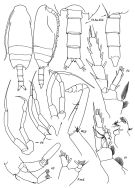 issued from : E.L. Markhaseva in Proc. Zool. Inst. RAN, St. Petersburg, 1996, 268. [p.127, Fig.97]. Male (from different localities). P.md: mandibular palp.
|
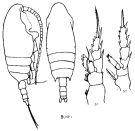 Issued from : K.A. Brodskii in Calanoida of the Far Eastern Seas and Polar Basin of the USSR. Opred. Fauna SSSR, 1950, 35 (Israel Program for Scientific Translations, Jerusalem, 1967) [p.153, Fig.66]. Female (from NW Pacif.): habitus (dorsal and lateral right side); S1, P1; S2, P2. Nota: Abdomen 1/3 length of cephalothorax. Abdominal segments 1 to 3 with denticulate posterior margins. 2nd basipodal segment of P1 with small spinule on outer distal margin.
|
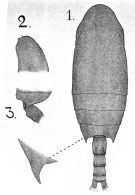 issued from : A. Scott in Siboga-Expedition, 1909, XIX a. [Plate XLIV, Figs.1-3]. As Chiridius ? obtusifrons. With doubt in C. polaris. Female (from Molucca Passage): 1, habitus (dorsal); 2, forehead (lateral); 3, last thoracic and genital segments (left side).
|
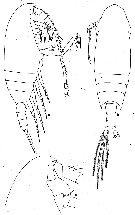 issued from : W. Vervoort in B.A.N.Z. Antarctic Reseach Expedition, Report Ser. B, Vol. III., 1957 [Fig.31]. Female (from 66°05'S, 73°50'E): a-b, habitus (lateral and dorsal, respectively); c, forehead (lateral).
|
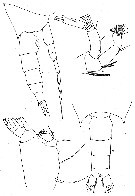 issued from : W. Vervoort in B.A.N.Z. Antarctic Reseach Expedition, Report Ser. B, Vol. III., 1957 [Fig.32]. Female: a, d, posterior part cephalothorax and urosome (lateral and dorsal, respectively); b, right A2; c, right Md (mandibular palp)
|
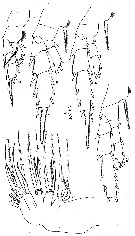 issued from : W. Vervoort in B.A.N.Z. Antarctic Reseach Expedition, Report Ser. B, Vol. III., 1957 [Fig.33]. Female: a, right P1 (anterior); b, left P2; c, left P3; c', detail of spinules along outer edge of terminal spine; d, left P4; e, right Mx2.
|
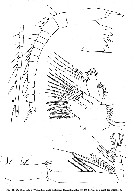 issued from : W. Vervoort in B.A.N.Z. Antarctic Reseach Expedition, Report Ser. B, Vol. III., 1957 [Fig.34]. Female: a-b, right A1; c, Md (cutting edge); d, right Mx1; e, right Mxp.
|
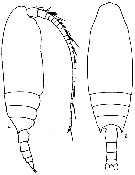 issued from : R.N. Wolfenden in Die Marinen Copepoden der Deutschen Südpolar-Expedition 1901-1903, 1911. [p.211, Fig.6]. Female (from Antarctic): a-b, habitus (lateral and dorsal, respectively).
|
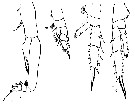 issued from : R.N. Wolfenden in Die Marinen Copepoden der Deutschen Südpolar-Expedition 1901-1903, 1911. [Pl.XXIV, Figs.9-12]. Female: 9, Mxp; 10, P1; 11, P2; 12, P4.
|
 Chiridius polaris Chiridius polaris female: 1 - Exopod of Mx1 with 10 setae. Points of last thoracic segment reaching to the end of first third of genital segment. 2 - Endopodal segment 2 of Md wuith 8 (7 terminal and 1 posterior) setae. 3 - Points of last thoracic segment reaching the end of first third of genital segment (sometimes reaching or exceeding its midlength). Exopodal segment 3 of P1 with external spine 1.04-1.26 longer than external spine of segment 2.
|
 Chiridius polaris Chiridius polaris male: 1 - Points of last thoracic segment not longer than genital segment. 2 - Right P5 longer than left. Exopodal segments 1 and 2 of P1 with external spines reaching more longer than midlength of the next segment. 3 - Points of last thoracic segment reaching the posterior border of genital segment. Endopodal segment 1 of Mxp with 3 medial setae. 4 - Endopodal segment 1 of P1 with external spine reaching and exceeding the base of following spine.
| | | | | Compl. Ref.: | | | Gowing & Wishner, 1986 (p.939, tab.3, gut contents); Zmijewska, 1987 (tab.2a); Hattori, 1991 (tab.1, Appendix); Razouls & al., 2000 (p.343, tab. 4, 5, Appendix); Park, W & al., 2004 (p.464, tab.1); Schnack-Schiel & al., 2008 (p.1045: Tab.2); Park & Ferrari, 2009 (p.143, Table 4, 6: bipolar distribution, Appendix 1, biogeography from Southern Ocean) | | | | NZ: | 5 + 2 doubtful | | |
|
Distribution map of Chiridius polaris by geographical zones
|
| | | | | | 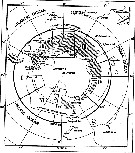 issued from : W. Vervoort in B.A.N.Z. Antarctic Reseach Expedition, Reports - Ser. B, Vol. III, 1957 [Fig.132] issued from : W. Vervoort in B.A.N.Z. Antarctic Reseach Expedition, Reports - Ser. B, Vol. III, 1957 [Fig.132]
Chart showing the geographical distribution (white triangle) in the seas surrounding the Antarctic continent.
Nota: In this chart the area frequented by whaling vessels has been hatched. The Antarctic circle (66°.5 S) has been drawn as a broken line. The numbers I to VI refer to the sectors into which the Antarctic seas are divided according to Mackintosh (1942) (after Vervoort, 1951). |
| | | | Loc: | | | Antarct. (Peninsula, W Weddell Sea, S Atlant., Indian, SW & SE Pacif.), sub-Antarct. (SE Pacif.), ? Indonesia-Malaysia, ? Japan, off Sanriku, Kuril-Kamtchatka Trench, British Columbia, off California (Santa Catalina Basin).
Type locality: Antarctic (South of 60° in the Indian sector) | | | | N: | 14 | | | | Lg.: | | | (5) F: 2,6; (10) F: 2,75; (20) F: 3,44; 3,36; (22) F: 3,5; (25) F: 4,3; (35) F: 4,14; (37) F: 4,25-3,3; M: 3,8-3,55; {F: 2,60-4,25; M: 3,55-3,80} | | | | Rem.: | Meso- to abyssopelagic.
Sampling depth (Antarct., sub-Antarct.) : 0-1000 m.
Bipoar species
There are some disagreements on the synonymies between Brodsky (1950) and later authors.
After Markhaseva (1996, p.123) the examination of this species demonstrated the significant variability in body size, length and shape or posterior points oflast thoracic segment (features used in distinguishing C. polaris, C. pacificus and C. subantarctic). The latter species is considered to be identical to C. polaris. The author foud this species in the Kuril-Kamchatka Trench between 2000 and 4000 m. | | | Last update : 21/01/2016 | |
|
|
 Any use of this site for a publication will be mentioned with the following reference : Any use of this site for a publication will be mentioned with the following reference :
Razouls C., Desreumaux N., Kouwenberg J. and de Bovée F., 2005-2025. - Biodiversity of Marine Planktonic Copepods (morphology, geographical distribution and biological data). Sorbonne University, CNRS. Available at http://copepodes.obs-banyuls.fr/en [Accessed December 25, 2025] © copyright 2005-2025 Sorbonne University, CNRS
|
|
 |
 |

















